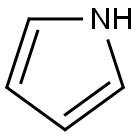?? C??? ??, ??, ??
??? ??
Six π-electrons are distributed over the five ring atoms of pyrrole. Delocalization
of these electrons stabilizes the ring and the lone pair of electrons on the nitrogen
atom, which is responsible for the usual basicity of nitrogen compounds, is
involved in the electron cloud, and is not available for sharing. Hence, pyrrole is an extremely weak base and the pyrrolic nitrogen is not readily susceptible to
electrophilic enzymic attack (Damani, 1985). There is a high electron density,
however, at all positions of the ring, which causes pyrrole to be reactive toward
electrophilic substitution. In general, electrophilic substitution reactions on the
neutral molecule occur preferentially at the C-2 or C-5 positions (Jones and Bean,
1977; Damani and Crooks, 1982).
??? ??
Pyrrole is a colorless to brown liquid that has a sweet, warm-ethereal smell, similar to chloroform. It dissolves in ethanol, ether, benzene, dilute acids, and most non-volatile oils but does not dissolve in water or dilute alkalis. When stored for extended periods, it tends to aggregate and become brown due to the influence of light.
??
ChEBI: 1H-pyrrole is a tautomer of pyrrole that has the double bonds at positions 2 and 4. It is a pyrrole and a secondary amine. It is a tautomer of a 2H-pyrrole and a 3H-pyrrole.
?? ??
Pyrrole originally was prepared industrially by fractional distillation of coal tar,
bone oil or other protein material, and purified through formation of its potassium
derivative (Runge, 1834; Michelman, 1925). Later it was produced by heating
ammonium mucate with glycerol or mineral oil (Blicke and Powers, 1927;
McElvain and Bollinger, 1941). It is now manufactured by addition of ammonia to
either acetylene or butadiene. Good yields of pyrrole also may be obtained from
the reaction of ammonia with the corresponding heterocyclic compound (furan) in
a vapor-phase process at 480° to 500°C, using alumina as a catalyst (Thompson,
1972) or by catalytic reaction of furan with ammonia over a molybdenum or
vanadium oxide catalyst at 350-400°C (Bishop and Denton, 1950).
?? ??
By fractional distillation of bone oil (bone oil is obtained by destructive distillation of animal bone) and subsequent purification via the corresponding potassium salt; by thermal decomposition of ammonium mucate in glycerol or mineral oil.
?? ??
Pyrrole is one of the flavor compounds that is formed in thermally processed foods due to the Maillard reaction.
???
Moderate fire risk. Toxic by ingestion and
inhalation.
????
Pyrrole is harmful if swallowed, inhaled, or absorbed through the skin. Its vapor or
mist is irritating to the eyes, mucous membranes and upper respiratory tract
(Lenga, 1985; Sax, 1984). Although no cases of occupational disease due to
pyrrole have been reported, it has a depressant action on the central nervous
system and, in severe intoxication, it is injurious to the liver. Tests indicate that it
has moderate cumulative toxicity (Parmegianni, 1983).
????
Combustible liquid; flash point (closed cup)
39°C (102°F); vapor forms explosive mixtures
with air; LEL and UEL values are not
available. Heating with strong oxidizers can
be violent.
?? ??
Pyrrole is used to a limited extent as a solvent for polymeric esters, but its primary
value lies in its function as a chemical intermediate. It is used in the synthesis of
non-heterocyclic compounds (Kozikowski, 1984) and its derivatives have been
used in the manufacture of dyes, herbicides, perfumes, and as cross-linking agents
for curing resins (Thompson, 1972). Derivatives of pyrrole are utilized in pharmaceutical
applications, particularly as anti-inflammation drugs and drugs with
central nervous system activity, including antihypertensive effects (Sundberg,
1984); and as antimicrobial agents (Freeman, 1975), such as fungicides (Zirngibl,
1983) and bactericides (Bailey and Johnson, 1973; Bailey et al 1973; Sundberg,
1984). Polymers of pyrrole have been used in the preparation of photoconductive
materials. The main utility of poly(pyrrole) has been for the modification of
electrode surfaces, although numerous other applications can be envisioned (Heilmann
and Rasmussen, 1984).
Safety Profile
Poison by ingestion, subcutaneous, and intraperitoneal routes. Flammable liquid when exposed to heat or flame; can react with oxilzing materials. To fight fire, use foam, CO2, dry chemical. Violent reaction with 2-nitrobenzaldehyde.
When heated to decomposition it emits highly toxic fumes of NOx.
Purification Methods
Dry pyrrole with NaOH, CaH2 or CaSO4. Fractionally distil it under reduced pressure from CaH2. Store it under nitrogen as it turns brown in air. Redistil it immediately before use. The picrate forms orange-red crystals with m 69o(dec). [Beilstein 20 H 4, 20 I 3, 20 II 3, 20 III/IV 61, 20/5 V 3.]
?? ?? ?? ? ???
???
?? ??









